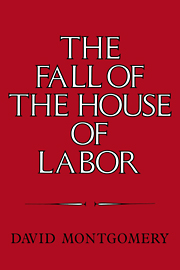Book contents
- Frontmatter
- Contents
- Acknowledgments
- Abbreviations used in text and notes
- Introduction
- 1 The manager's brain under the workman's cap
- 2 The common laborer
- 3 The operative
- 4 The art of cutting metals
- 5 White shirts and superior intelligence
- 6 “Our time … believes in change”
- 7 Patriots or paupers
- 8 “This great struggle for democracy”
- 9 “A maximum of publicity with a minimum of interference”
- Index
5 - White shirts and superior intelligence
Published online by Cambridge University Press: 11 September 2009
- Frontmatter
- Contents
- Acknowledgments
- Abbreviations used in text and notes
- Introduction
- 1 The manager's brain under the workman's cap
- 2 The common laborer
- 3 The operative
- 4 The art of cutting metals
- 5 White shirts and superior intelligence
- 6 “Our time … believes in change”
- 7 Patriots or paupers
- 8 “This great struggle for democracy”
- 9 “A maximum of publicity with a minimum of interference”
- Index
Summary
The revitalization of industrial capitalism at the end of the 1890s was international in scope, and the optimism and sense of achievement it unleashed in intellectual and political life were exuberant. The French economist Leon Dupriez calculated that the average annual change in physical output per capita for the advanced industrial countries as a group between 1895 and 1913 was double what it had been between 1880 and 1894. The United States, which had already emerged during the 1880s as the world's leading industrial producer, increased its output even more rapidly than its leading rivals, England, Germany, and France. Its factories grew to dwarf the largest works of the nineteenth century. Electricaland farm-equipment companies, meat-packing firms, woolen and silk mills, and, above all, automobile producers overtook the older, railroad-related giants – steel mills and railroad locomotive and car companies – by employing fifteen thousand to twenty thousand workers in a single complex of factory buildings. Great as the infusion of workers was, however, the new epoch also benefited from dramatic increases in output per worker. Data from the U.S. Census of Manufactures indicate that whereas the number of wage earners in American manufacturing had risen 37 percent between 1899 and 1909, the value added per worker had grown by more than 40 percent.
Much of the vast amount of capital at the disposal of business had been fed back into reinforced-concrete factory buildings and electrically powered machines.
- Type
- Chapter
- Information
- The Fall of the House of LaborThe Workplace, the State, and American Labor Activism, 1865–1925, pp. 214 - 256Publisher: Cambridge University PressPrint publication year: 1987
- 3
- Cited by



